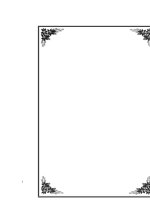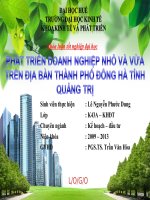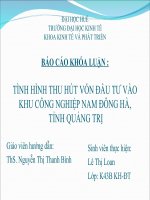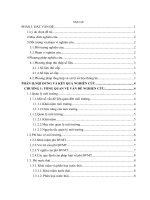Technical efficiency of oyster mushroom production in Dong Ha city, Quang Tri province: An application of output oriemted data envelopment analysis
Bạn đang xem bản rút gọn của tài liệu. Xem và tải ngay bản đầy đủ của tài liệu tại đây (303.09 KB, 5 trang )
Hue University Journal of Science
ISSN 1859-1388
Vol. 113, No. 14, 2015, pp. 17-21
TECHNICAL EFFICIENCY OF OYSTER MUSHROOM
PRODUCTION IN DONG HA CITY, QUANG TRI PROVINCE:
AN APPLICATION OF OUTPUT ORIENTED DATA
ENVELOPMENT ANALYSIS
Ton Nu Hai Au*, La ThiThuy Dung
College of Economics, Hue University
Abstract: Based on cross section data of 30 oyster mushroom farms in Dong Ha city, Quang Tri province,
this study estimated their technical efficiency level by using output-oriented Data Envelopment Analysis
(DEA). The empirical results indicate that oyster mushroom farms should expand their current level of
output from 9 to 17% to be efficient. Moreover, the results also reveal that technical inefficiency of oyster
mushroom in Dong Ha city, Quang Tri province was mainly due to scale inefficiency. Most of the farms
should increase their current scale to improve their technical efficiency.
Keywords: Technical efficiency, oyster mushroom, output oriented DEA
1
Introduction
Cultivating mushrooms, especially Oyster mushroom on straw and sawdust in Dong Ha city of Quang
Tri province, has been being considered as a mean of not only taking advantage of by-products of
agriculture but also giving job opportunities and increasing returns for the farmers [2]. However, up to
now, this model has been developed spontaneously and experientially in this area [6]. Many questions
such as: whether the farmers could attain the level of production they should be comparing to the best
practice farms, what their technical efficiency levels are, and how many percent of output should be
expanded without using more input have still not been answered.
Using output-oriented Data Envelopment Analysis, this paper aims to answer the above
questions by estimating the technical efficiency of oyster mushroom farms in Dong Ha city, Quang Tri
province.
2
Data and Methodology
Data
Primary data of this research were based on farm level cross-section data of oyster mushroom in Dong
Ha city, Quang Tri province in the crop year of 2014. The data are collected from a field survey in 2015.
The sample size was 30 farm households, in which 24 farms used sawdust and 6 used straw to cultivate
oyster mushroom.
Secondary data for this study were collected from Bureau of Statistics, Department of Agriculture
and Rural Development of Quang Tri province. They were also from books, journals, research reports,
previous studies and so on.
*Corresponding:
Submitted: October 03, 2015; Revised: December 01, 2016; Accepted: February 25, 2016.
Ton Nu Hai Au et al.
Vol. 113, No.14, 2015
Methodology
Efficiency can be considered in terms of input-orientation or output-orientation. In which, inputorientated efficiency finds out a target point maximizing the proportion reduction in inputs or produces a
given level of output from an optimal combination of inputs. Meanwhile output-orientated efficiency
finds out a target point that maximizes the proportional augmentation in outputs or produces the
optimal output from a given set of inputs [5].
Up to now, most DEA applications to efficiency measurements in the literature have been inputbased type. A few published applications of output-based efficiency have primarily focused on technical
scale and congestion efficiency [3]. Meanwhile, in oyster mushroom cultivation, the amount of inputs
used such as seedling, electricity and labor (except water) are almost the same for every farm, only the
level of production is unknown. Therefore, output orientated data envelopment approach is appropriate
to describe the production possibility situation.
The output-orientated VRS model used to estimate technical efficiency of oyster mushroom farms
in this study is as follows:
𝑀𝑎𝑥∅,𝜆 𝜙,
St
−𝜙𝑞𝑖 + 𝑄𝜆 ≥ 0
𝑥𝑖 − 𝑋𝜆 ≥ 0
𝑁
∑ 𝜆𝑖 = 1
𝑖=1
𝜆≥0
Where 1 ≤ ∅ < ∞, and ∅ − 1 is the proportional increase in outputs that could be achieved by the
i-th farm, with input quantities held constant. 1/∅ defines a technical efficiency score that varies between
zero and one. The vector is an Nx1 vector of weights (constants) which defines the linear
combination of the peers of the i-th farm. Q is a vector of output quantities and X is a vector of
observed inputs. The farm is technically efficient and on the frontier if 1/∅ is equal to one. On
the contrary, if 1/∅ is less than one, the farm is technically inefficient. That farm can still expand
further the level of output produced without using more inputs [1, 5].
Output-oriented technical efficiency is studied to answer the question: “By how much can output
quantities be proportionally expanded without altering the input quantities used?” and efficiency is
measured by the ratio of OA and OB based on the figure below. In this figure, the firms which are on the
frontier curve ZZ’ are technically efficient. Point A lies below the ZZ’ curve. Hence, A is an inefficient
point. And the distance AB represents technical inefficiency that outputs could be expanded without
requiring extra inputs [1, 5].
18
Jos.hueuni.edu.vn
Vol. 113, No.14,2015
Fig. 1. Output-orientated measures
Source: [5]
This study used Vietnamese DEA add‐in for Excel to estimate the technical efficiency of oyster
mushroom farms in Dong Ha city, Quang Tri province [4].
3
Results and discussion
In Dong Ha city, two main materials used to create seedling bag in cultivating oyster mushroom are
straw and sawdust. Table 1 presents a summary of descriptive statistics of inputs and output of 30 oyster
mushroom farms, including 24 farms (accounted for 80%) used sawdust and 6 farms (only account for
20%) used straw in cultivating in 2014.
Table 1. Inputs and Output per square meter of Oyster mushroom farms in Dong Ha city,
Quang Tri province
Units
Sawdust bag group
(n = 24)
Straw bag group
(n = 6)
Total
Mean
St.Dev
Mean
St.Dev
Mean
St.Dev
Inputs
Labor
Hour
12.657
2.872
19.305
8.504
13.986
5.131
Water
Cubic meter
0.023
0.006
0.030
0.012
0.024
0.008
Electricity
Kilowatt-hour
2.744
1.464
4.232
2.223
3.042
1.708
Seedling
Bag
18.439
4.556
28.072
14.244
20.365
8.174
Kilogram
14.762
4.893
26.874
15.166
17.184
9.106
Output
Oyster mushroom
Source: Field survey in 2015
19
Ton Nu Hai Au et al.
Vol. 113, No.14, 2015
Table 1 shows that in order to cultivate, on average, from 18 to 28 seedling bags per square meter,
a farm had to water from 0.023 to 0.03 cubic meter and use from 2.7 to 4.2 kilowatt-hour of electricity.
Moreover, the family labor in an oyster mushroom farm, on average, had to spend from 12 to 19 hours
per square meter per crop in seedling making, watering, harvesting and so on. In which, straw bag farms
used more water, electricity and spent more time on cultivating than sawdust bag groups.
The average oyster mushroom production of those farms was from 14.7 to 26.9 kilograms per
square meter, in which the production of straw bag group almost doubled the sawdust bag one.
Table 2 gives information on the range and the mean technical efficiency scores of samples which
were categorized into sawdust and straw bag groups.
Table 2. Technical efficiency of Oyster mushroom farms in Dong Ha city, Quang Tri province
Sawdust bag group
(n = 24)
Straw bag group
(n = 6)
TECRS
TEVRS
TECRS
TEVRS
Min
0.3750
0.6260
0.6340
0.6880
Max
1.0000
1.0000
1.0000
1.0000
Mean
0.8286
0.8766
0.8528
0.9131
St.Dev
0.1375
0.1281
0.1665
0.1385
3
12
3
4
12.5
50
50
66.7
Efficient
No. of farms
farms
%
Source: Field survey and authors’ calculation in 2015
Notes: TE CRS: Technical efficiency under constant returns to scale
TE VRS: Technical efficiency under variable returns to scale
The result in table 2 shows the difference between VRS and CRS technical efficiency in both
groups. This indicates the existence of scale inefficiency in the sample farms, in which assuming that all
farms are operating at optimal scale (under constant return to scale - CRS), there were 3 out of 24 sawdust
farms (accounted for 12.5%) and 3 out of 6 straw bag group farms (accounted for 50%) being CRS
technically efficient with the means of 0.83 and 0.85, respectively. This means that under constant return
to scale those farms could potentially expand the current level of output by 15 to 17 percent without
requiring extra inputs.
Meanwhile, 12 out of 24 sawdust bag group farms (accounted for 50 percent) and 4 out of 6
(accounted for 66.7%) were technically efficient under variable return to scale (VRS) with the means of
0.88 and 0.91, respectively. This means that under variable return to scale, the oyster production could
proportionally be increased by 9 to 12 percent without altering the input quantities used.
The results in table 3 indicate that in the sample, only 12.5% of sawdust bag group are scale
efficient while 75% or 18 out of 24 farms should increase their scale to be efficient. 3 left farms were
indicated to decrease their scale to gain efficiency.
The result in table 3 also shows that 50% of straw bag group were operating at optimal scale while
50% left should increase scale to be efficient.
20
Jos.hueuni.edu.vn
Vol. 113, No.14,2015
Table 3. Summary of returns to scale results of Oyster mushroom farms in Dong Ha city,
Quang Tri province
Sawdust bag group
Straw bag group
Total
No. of farms
%
No. of farms
%
No. of farms
%
CRS
3
12.5
3
50
6
20
IRS
18
75
3
50
21
70
DRS
3
12.5
0
0
3
10
Source: Field survey and authors’ calculation in 2015
Notes: CRS: Constant return to scale,
IRS: Increasing return to scale,
DRS: Decreasing return to scale
4
Conclusion
This study employed output-oriented data envelopment analysis to measure technical efficiency of
oyster mushroom farms in Dong Ha city of Quang Tri province. The analysis results show that the mean
technical efficiency of straw and sawdust bag groups were 0.85 and 0.83 under constant return to scale,
and 0.91 and 0.88 under variable return to scale, respectively. Moreover, those results also revealed that
technical inefficiency of oyster mushroom in Dong Ha city of Quang Tri province was mainly due to
scale inefficiency.
Based on the above conclusions, some recommendations can be made. Oyster mushroom farms
should expand their current level of output from 9 to 17% to be efficient. This information might be useful
for local government authorities in training extension workers or operating training workshops.
Moreover, most of the farms should increase their current scale to improve their technical efficiency.
Reference
1. Cooper, W.W., Seiford, L.M., Zhu, J., (2004), Data Envelopment Analysis History, Models and
Interpretations, Hand book of Data Envelopment Analysis.
2. Nair, E. M. a. N. G. T., (2009), Make money by growing mushroom. Rome, Food and Agriculture
Organization of the United Nations.
3. Sharma, K. R., et al. (1999), Economic efficiency and optimum stocking densities in fish polyculture: an
application of data envelopment analysis (DEA) to Chinese fish farms. Aquaculture 180(3-4): 207-221
4. Thanh, N.D., (2015), Vietnamese DEA add‐in for Excel, National Economics University in Ha Noi and
Massey Business School, New Zealand.
5. Timothy J. Coelli, D.S. Prasada Rao, et al., (2005), An Introduction to Efficiency and Productivity Analysis,
Second Edition, Springer: 172.
6. Trung tâm ứng dụng tiến bộ KH&CN QuảngTrị, (2009), Báo cáo tổng kết dự án “Xây dựng mô hình sản
xuất giống, nuôi trồng, chế biến và tiêu thụ nấm ăn, nấm dược liệu tại tỉnh Quảng Trị”
21









